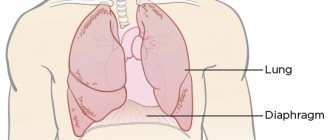What is heart failure?
Heart failure is a pathological condition caused by the inability of the heart to provide adequate blood supply to organs and tissues during exercise, and in more severe cases, at rest. In heart failure, the heart is not able to effectively pump blood, and therefore the circulation of oxygen and nutrients in the body is disrupted, which leads to stagnation of blood in the tissues, swelling in the legs, in severe cases in the abdominal cavity (ascites), in the lungs . Heart failure is not an independent disease; it is considered a complication of other diseases and conditions. In the United States, heart failure affects about 1% of the population (2.5 million people). Heart failure accounts for one in 20 hospitalizations and is more fatal than many types of cancer. The incidence of heart failure increases with age—10% of the population over 75 years of age in the United States.
Classification
There is a classification of CHF according to the stages of development of the disease (N.D. Strazhesko, V.Kh. Vasilenko):
Stage I (initial) - signs of deficiency appear only during physical activity, there are no symptoms at rest.
Stage II is divided into two periods:
- period A – clinically pronounced disorder of the right or left side of the heart, congestion in the pulmonary or systemic circulation, shortness of breath and symptoms occur with little physical effort;
- period B – stagnation in both circles of blood circulation (manifested by shortness of breath, swelling), performance is sharply reduced.
Stage III (final) - changes in the structure of organs and tissues, due to impaired blood supply and trophism, shortness of breath at rest.
The severity of the disease is determined by the functional class (FC), which shows how limited the patient’s physical activity is.
- I FC - no restrictions on physical activity. Normal physical activity does not cause excessive shortness of breath, fatigue, or palpitations;
- FC II - minor limitation in physical activity. Feel comfortable at rest, but normal physical activity causes shortness of breath, fatigue, or palpitations;
- III FC is a clear limitation of physical activity. Feeling comfortable at rest but doing less physical activity than usual causes excessive shortness of breath, fatigue, or palpitations;
- IV FC - inability to perform any physical activity without discomfort. Symptoms may be present at rest. With any physical activity, discomfort increases.
The disease should not be allowed to develop; timely diagnosis will help prevent the occurrence of pathology. Our cardiology center of the Federal Scientific and Clinical Center of the Federal Medical and Biological Agency invites you to undergo a comprehensive heart examination. Timely identification of the cause of heart failure and its treatment will help maintain your quality of life.
Symptoms of heart failure
When the heart does not work efficiently, people notice that they expend more energy than before when doing the same work, they get tired faster, and experience rapid breathing (shortness of breath). This is due to the fact that the tissues do not receive enough oxygen. Arrhythmias, dizziness, darkening of the eyes, fainting, swelling of the neck veins, pale skin, swelling in the ankle area - which is called edema and is associated with the accumulation of excess fluid in the tissues - may occur. The skin becomes “loose” and if you press on it with your finger, the resulting “dent” or hole remains for quite a long time. As heart failure progresses, the level of edema observed becomes higher; tissue pastiness can be noticed even in the abdomen and lower back.
These symptoms tend to develop gradually and usually go unnoticed for a long time. Symptoms of heart failure increase, the general condition slowly deteriorates and increasingly affects the person's ability to perform normal work. There are often periods when a person's condition remains fairly stable, interspersed at times with episodes of acute worsening of symptoms. In the later stages, complaints arise not only during exercise, but also at rest, and the ability to work is completely lost. Due to insufficient blood supply, all organs and systems of the body suffer to one degree or another. Abnormal heart rhythms are a bad sign of heart failure—about half of people with heart failure die suddenly as a result of fatal arrhythmias.
The main complaints of patients with the development of heart failure:
- Swelling of the soft tissues of the feet and legs are the initial symptoms of right ventricular heart failure, uniformly affecting both legs, occurring in the late afternoon and disappearing by the morning. With the development of insufficiency, the swelling becomes dense and does not go away completely, ordinary shoes become tight, patients feel comfortable only in house slippers.
- Ascites is an accumulation of fluid in the abdominal cavity.
- Enlargement of the liver - discomfort (unpleasant sensations, heaviness) and pain in the right hypochondrium.
- Fast fatiguability.
- Dyspnea is the main, often the first symptom of chronic left ventricular failure. As heart failure progresses, shortness of breath may occur during normal conversation, and sometimes even at complete rest.
- Paroxysmal cough after performing intense exercise.
- Rapid heartbeat (sinus tachycardia) is a feeling of “fluttering” in the chest that occurs during any physical activity.
Treatment of the disease
It is necessary to distinguish between the treatment of heart failure occurring in acute and chronic form.
Treatment of acute heart failure. This disease begins sharply and suddenly. It grows quickly and then turns into an attack of suffocation. There is a severe cough with expectoration of foamy contents and other symptoms of pulmonary edema or cardiac asthma. Therefore, treatment of heart failure begins with calling a doctor and providing first aid. The patient is admitted to the hospital, where he is under strict supervision. The cardiologist, in accordance with the patient’s condition, prescribes an appropriate course of treatment.
Treatment of chronic heart failure. It is usually carried out at home. The process begins with treating the disease that caused the syndrome to develop. It is important to maintain psycho-emotional peace and engage in physical therapy in a medical institution (only under the supervision of a specialist with appropriate education).
A diet must be prescribed, limiting fluid intake to 1,200 ml and salt to 4 g (sometimes to 1-2 g per day). Food should be high in proteins, minerals and vitamins. Consumption of carbohydrates and fried foods is necessary to reduce the risk of obesity. Patients with heart failure are prohibited from eating spicy foods.
If edema is present, diuretics are prescribed. Sometimes they are combined with drugs containing potassium. During the period of use, you need to monitor the results of a blood test to determine the level of uric acid, potassium, sodium and monitor the acid-base balance.
Surgical methods for treating heart failure. Such treatment methods include:
- coronary artery bypass grafting;
- operations on heart valves, which lead to a decrease in the load on the myocardium;
- heart transplantation.
Diagnosis of heart failure
Electrocardiography (ECG) helps doctors identify signs of hypertrophy and insufficient blood supply (ischemia) of the myocardium, as well as various arrhythmias.
An ECG with a load - a special modification of a bicycle (bicycle ergometry) or a “treadmill” (treadmill) - provides information about the reserve capabilities of the pumping function of the heart.
Echocardiography (EchoCG). Using this method, you can not only determine the cause of heart failure, but also evaluate the contractile function of the ventricles of the heart.
X-ray examination of the chest organs in heart failure reveals stagnation of blood in the pulmonary circulation and an increase in the size of the heart cavities (cardiomegaly).
Radioisotope methods for studying the heart, in particular radioisotope ventriculography, make it possible to assess with high accuracy the contractile function of the ventricles of the heart and the volume of blood they contain in patients with heart failure. These methods are based on the administration and subsequent distribution of radioisotope drugs in the body.
Positron emission tomography – PET – allows using a special radioactive “tag” to identify areas of viable myocardium in patients with heart failure.
Diagnostics
Diagnosing heart failure is fairly easy. In people with heart disease, diagnosis is usually made based on clinical presentation using the NYHA (New York Heart Association) classification.
Echocardiography and other instrumental methods are used to identify the preclinical stage, when there are almost no obvious symptoms of heart failure. For early diagnosis, it is very important to conduct a special stress test, since most often only this can determine the presence of the disease. In this regard, patients with heart disease need to undergo a medical examination with their attending physician once every 6 months with appropriate tests.
Treatment of heart failure
If acute heart failure develops, hospitalization is necessary. The main emphasis in treatment is both on eliminating the causes of heart failure (stress, excessive consumption of table salt, alcohol abuse, smoking, high blood pressure, as well as taking medications that promote fluid retention in the body, etc.), and on correcting it manifestations. Limiting physical activity. Physical activity is acceptable and desirable, but it should not cause significant fatigue or discomfort. The diet should be low in salt, with plenty of fruits and vegetables. It is very important to achieve a reduction in excess weight, as it creates a significant additional burden on a diseased heart.
Currently, the following medications are used to treat heart failure:
- increased myocardial contractility;
- decreased vascular tone;
- reducing fluid retention in the body;
- elimination of sinus tachycardia;
- prevention of thrombus formation in the cavities of the heart.
If medications used to treat chronic heart failure are ineffective, surgical treatment may be recommended - cardiomyoplasty, cardiac pacing. Typically, medical monitoring of patients with heart failure is necessary throughout their lives.
Causes of the disease
The main causes of acute heart failure include the following diseases:
- pulmonary embolism;
- myocardial infarction;
- decompensation of CHF;
- cardiac tamponade;
- acute valvular insufficiency;
Heart rhythm disturbances and injuries to the heart muscle can also cause the disease.
The main reasons leading to the development of chronic heart failure:
- cardiosclerosis;
- angina pectoris (chronic ischemic heart disease);
- diseases of the valve apparatus of the heart muscle;
- arterial hypertension;
- chronic pulmonary heart disease.








